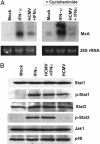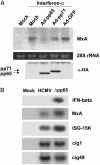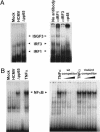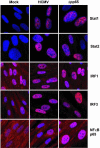Human cytomegalovirus UL83-coded pp65 virion protein inhibits antiviral gene expression in infected cells
- PMID: 12972646
- PMCID: PMC208776
- DOI: 10.1073/pnas.1534570100
Human cytomegalovirus UL83-coded pp65 virion protein inhibits antiviral gene expression in infected cells
Abstract
The initial interaction of human cytomegalovirus with fibroblasts triggers, and then partially blocks, an innate immune response pathway that leads to the induction of IFN-responsive genes and proinflammatory chemokines. Infection of fibroblasts with human cytomegalovirus inhibited their ability to respond to exogenous IFN. Consistent with the observation that the block did not depend on de novo viral protein synthesis, ectopic expression of the viral UL83-coded pp65, an abundant virion protein, inhibited IFN signaling. Furthermore, DNA array analysis showed that infection with a pp65-deficient mutant virus caused a much stronger induction of many IFN-response and proinflammatory chemokine RNAs than infection with wild-type virus. The nuclear DNA-binding activities of transcription factors NF-kappaB and IRF1 were induced to a much greater extent after infection with the pp65-deficient mutant than with wild-type virus. IFN-stimulated gene factor 3 DNA-binding was modestly enhanced, whereas IRF3 activity was not affected by mutation of pp65. Together, these results imply that pp65, which is delivered to newly infected cells in the virion, antagonizes a pathway that affects NF-kappaB and IRF1 and prevents the accumulation of mRNAs encoded by numerous cellular antiviral genes.
Figures






Similar articles
-
Major human cytomegalovirus structural protein pp65 (ppUL83) prevents interferon response factor 3 activation in the interferon response.J Virol. 2004 Oct;78(20):10995-1006. doi: 10.1128/JVI.78.20.10995-11006.2004. J Virol. 2004. PMID: 15452220 Free PMC article.
-
Human Cytomegalovirus Tegument Protein pp65 (pUL83) Dampens Type I Interferon Production by Inactivating the DNA Sensor cGAS without Affecting STING.J Virol. 2018 Feb 26;92(6):e01774-17. doi: 10.1128/JVI.01774-17. Print 2018 Mar 15. J Virol. 2018. PMID: 29263269 Free PMC article.
-
Stably expressed antisense RNA to cytomegalovirus UL83 inhibits viral replication.J Virol. 1996 Apr;70(4):2086-94. doi: 10.1128/JVI.70.4.2086-2094.1996. J Virol. 1996. PMID: 8642628 Free PMC article.
-
The human cytomegalovirus tegument protein pp65 (pUL83): a key player in innate immune evasion.New Microbiol. 2018 Apr;41(2):87-94. Epub 2018 Jan 31. New Microbiol. 2018. PMID: 29384558 Review.
-
Multifaceted evasion of the interferon response by cytomegalovirus.J Interferon Cytokine Res. 2009 Sep;29(9):609-19. doi: 10.1089/jir.2009.0064. J Interferon Cytokine Res. 2009. PMID: 19708810 Free PMC article. Review.
Cited by
-
Human cytomegalovirus infection dysregulates the canonical Wnt/β-catenin signaling pathway.PLoS Pathog. 2012;8(10):e1002959. doi: 10.1371/journal.ppat.1002959. Epub 2012 Oct 11. PLoS Pathog. 2012. PMID: 23071438 Free PMC article.
-
Synthetic DNA approach to cytomegalovirus vaccine/immune therapy.Adv Exp Med Biol. 2015;848:131-48. doi: 10.1007/978-1-4939-2432-5_7. Adv Exp Med Biol. 2015. PMID: 25757619 Free PMC article. Review.
-
Major human cytomegalovirus structural protein pp65 (ppUL83) prevents interferon response factor 3 activation in the interferon response.J Virol. 2004 Oct;78(20):10995-1006. doi: 10.1128/JVI.78.20.10995-11006.2004. J Virol. 2004. PMID: 15452220 Free PMC article.
-
Human cytomegalovirus protein kinase UL97 forms a complex with the tegument phosphoprotein pp65.J Virol. 2007 Oct;81(19):10659-68. doi: 10.1128/JVI.00497-07. Epub 2007 Jul 18. J Virol. 2007. PMID: 17634236 Free PMC article.
-
The tegument protein pp65 of human cytomegalovirus acts as an optional scaffold protein that optimizes protein uploading into viral particles.J Virol. 2014 Sep 1;88(17):9633-46. doi: 10.1128/JVI.01415-14. Epub 2014 Jun 11. J Virol. 2014. PMID: 24920816 Free PMC article.
References
-
- Mendelson, M., Monard, S., Sissons, P. & Sinclair, J. (1996) J. Gen. Virol. 77, 3099–3102. - PubMed
-
- Jarvis, M. A. & Nelson, J. A. (2002) Curr. Opin. Microbiol. 5, 403–407. - PubMed
-
- Gutermann, A., Bubeck, A., Wagner, M., Reusch, U., Menard, C. & Koszinowski, U. H. (2002) Curr. Top. Microbiol. Immunol. 269, 1–22. - PubMed
Publication types
MeSH terms
Substances
Grants and funding
LinkOut - more resources
Full Text Sources
Other Literature Sources

